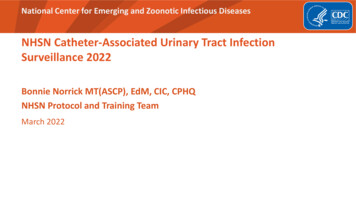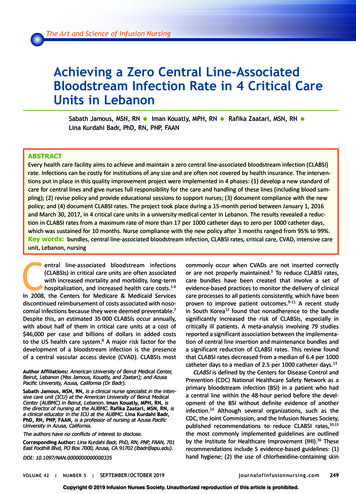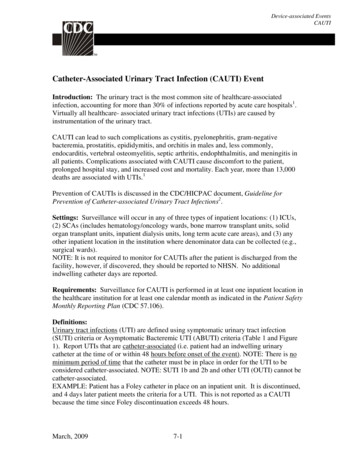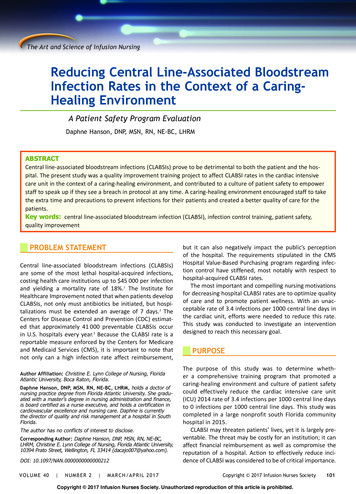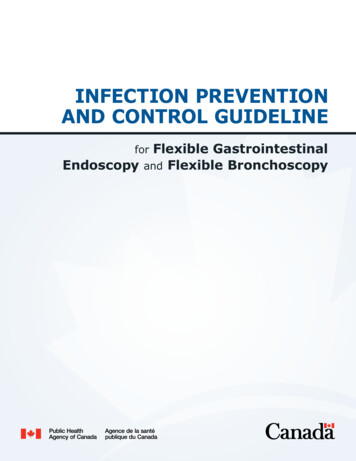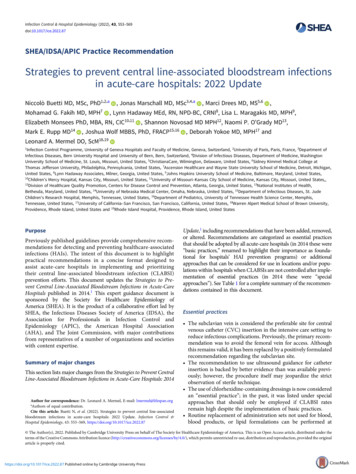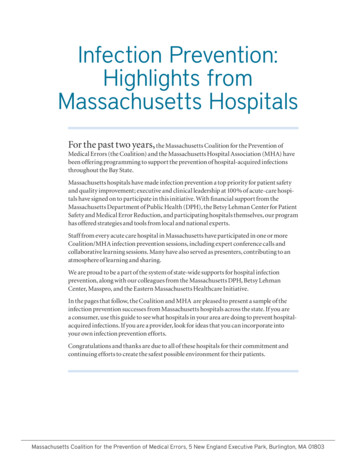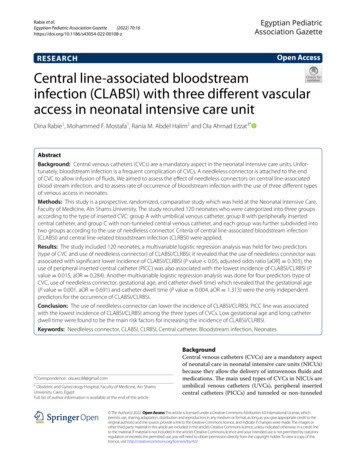
Transcription
Rabie et al.Egyptian Pediatric Association Gazette(2022) ptian PediatricAssociation GazetteOpen AccessRESEARCHCentral line‑associated bloodstreaminfection (CLABSI) with three different vascularaccess in neonatal intensive care unitDina Rabie1, Mohammed F. Mostafa1, Rania M. Abdel Halim2 and Ola Ahmad Ezzat3*AbstractBackground: Central venous catheters (CVCs) are a mandatory aspect in the neonatal intensive care units. Unfortunately, bloodstream infection is a frequent complication of CVCs. A needleless connector is attached to the endof CVC to allow infusion of fluids. We aimed to assess the effect of needleless connectors on central line-associatedblood stream infection, and to assess rate of occurrence of bloodstream infection with the use of three different typesof venous access in neonates.Methods: This study is a prospective, randomized, comparative study which was held at the Neonatal Intensive Care,Faculty of Medicine, Ain Shams University. The study recruited 120 neonates who were categorized into three groupsaccording to the type of inserted CVC: group A with umbilical venous catheter, group B with peripherally insertedcentral catheter, and group C with non-tunneled central venous catheter, and each group was further subdivided intotwo groups according to the use of needleless connector. Criteria of central line-associated bloodstream infection(CLABSI) and central line-related bloodstream infection (CLRBSI) were applied.Results: The study included 120 neonates, a multivariable logistic regression analysis was held for two predictors(type of CVC and use of needleless connector) of CLABSI/CLRBSI, it revealed that the use of needleless connector wasassociated with significant lower incidence of CLABSI/CLRBSI (P value 0.05, adjusted odds ratio [aOR] 0.303), theuse of peripheral inserted central catheter (PICC) was also associated with the lowest incidence of CLABSI/CLRBSI (Pvalue 0.015, aOR 0.284). Another multivariable logistic regression analysis was done for four predictors (type ofCVC, use of needleless connector, gestational age, and catheter dwell time) which revealed that the gestational age(P value 0.001, aOR 0.691) and catheter dwell time (P value 0.004, aOR 1.313) were the only independentpredictors for the occurrence of CLABSI/CLRBSI.Conclusion: The use of needleless connector can lower the incidence of CLABSI/CLRBSI, PICC line was associatedwith the lowest incidence of CLABSI/CLRBSI among the three types of CVCs. Low gestational age and long catheterdwell time were found to be the main risk factors for increasing the incidence of CLABSI/CLRBSI.Keywords: Needleless connector, CLABSI, CLRBSI, Central catheter, Bloodstream infection, Neonates*Correspondence: ola.aez.88@gmail.com3Obstetric and Gynecology Hospital, Faculty of Medicine, Ain ShamsUniversity, Cairo, EgyptFull list of author information is available at the end of the articleBackgroundCentral venous catheters (CVCs) are a mandatory aspectof neonatal care in neonatal intensive care units (NICUs)because they allow the delivery of intravenous fluids andmedications. The main used types of CVCs in NICUs areumbilical venous catheters (UVCs), peripheral insertedcentral catheters (PICCs) and tunneled or non-tunneled The Author(s) 2022. Open Access This article is licensed under a Creative Commons Attribution 4.0 International License, whichpermits use, sharing, adaptation, distribution and reproduction in any medium or format, as long as you give appropriate credit to theoriginal author(s) and the source, provide a link to the Creative Commons licence, and indicate if changes were made. The images orother third party material in this article are included in the article’s Creative Commons licence, unless indicated otherwise in a credit lineto the material. If material is not included in the article’s Creative Commons licence and your intended use is not permitted by statutoryregulation or exceeds the permitted use, you will need to obtain permission directly from the copyright holder. To view a copy of thislicence, visit http:// creat iveco mmons. org/ licen ses/ by/4. 0/.
Rabie et al. Egyptian Pediatric Association Gazette(2022) 70:16central venous catheters [1]. Unfortunately, using of theseCVCs is linked to several complications, bloodstreaminfection is one of the most frequent and fatal complication that can be encountered [2]. Neonatal population arespecifically at higher risk of fatal bloodstream infectionbecause of many reasons such as the difference in thenature of their immunological system response such aschanges in neutrophils function due to gestational age orrelative deficiency in immunoglobulin or complementslevel especially in premature neonates, also their immature skin barrier can add up to this risk [3].A needleless connector is a piece attached to the endof central vascular catheters to allow infusion and aspiration of fluid and medications into the catheter [4]. It has aprotective split septum that opens the fluid pathway onlywhen a male luer has been inserted and then automatically seals when disconnected. Before the introductionof needleless connector, 3-way stopcocks were used as atraditional way [4]. This prospective study assesses theeffect of needleless connectors on the central line-associated blood stream infection and the rate of occurrenceof bloodstream infection with the use of three differenttypes of venous access in neonates.MethodsStudy designThis study is a prospective, randomized, comparative study held at Neonatal Intensive Care Unit, Facultyof Medicine, Ain Shams University over 2 years fromSeptember 2019 to August 2021. This study has beenapproved by the Research Ethics Committee of Facultyof Medicine, Ain Shams University (approval number:MS292/2019). A written informed consent was takenfrom all parents or the legal guardians of the enrolledneonates after full explanation of the aim and plan of thework.Study population and settingThe study recruited 120 neonates with inserted CVC whowere categorized into three groups according to the typeof inserted CVC (umbilical venous catheter, peripheralinserted central catheter, non-tunneled central venouscatheter); each group was subdivided into two groupsaccording to the use of the needleless connector.Inclusion criteriaNeonates with umbilical venous catheter or peripheralinserted central catheter or non-tunneled central venouscatheter.Exclusion criteriaNeonates who had more than one type of central venouscatheters, neonates who had the central venous catheterPage 2 of 7placed for less than 24 h, neonates with congenital anomalies and karyotyping abnormalities, neonates with laboratory confirmed sepsis before insertion of the catheter.All included 120 neonates were categorized into 3 groupsaccording to the type of inserted CVC; group A: 40 neonates (40) with umbilical venous catheter, then subdivided into 2 groups: group A1 20 neonates (20) withumbilical venous catheter and needleless connector andgroup A2 20 neonates (20) with umbilical venous catheter but without needleless connector. Group B: 40 neonates (40) with peripherally inserted central catheter,furthermore, subdivided into 2 groups; group B1 20 neonates (20) with peripherally inserted central catheter andneedleless connector and group B2 20 neonates (20) withperipherally inserted central catheter but without needleless connector. Group C included 40 neonates (40) withnon-tunneled central venous catheter, additionally subdivided into two subgroups; group C1 included 21 neonates (21) with non-tunneled central venous catheter andneedleless connector and group C2: included 19 neonates(19) with non-tunneled central venous catheter but without needleless connector.All neonates were subjected to recording of the dateof central line insertion, the date of central line removal,determination of the catheter dwell time, gestational age,and assessment of the Hematological Scoring System(HSS) [5]. On the day of catheter removal, full generalexamination and laboratory investigations were done(catheter tip colonization, blood culture, and completeblood count).Microbiological techniquesBlood cultureA sterile syringe was used to collect blood samples (3ml) from a peripheral puncture under complete asepticcondition to be inoculated on BD BACTEC Peds Plus media then positive cultures were further sub-cultured inblood agar plates.Catheter tip cultureCatheters were removed when no longer required or withHSS 2 due to possibility of sepsis [6]. Catheters wereremoved using a sterile scissor, and 5 cm of the distaltip of the catheter was cut off and transferred in steriletransport container to the microbiology laboratory. Asemi-quantitative culture was carried out by using bloodagar plate and it was incubated aerobically at 35 C. It wasconsidered positive when 15 CFU/ml.The following definitions were applied according tothe results of cultures. Central line-related blood streaminfection (CLRBSI) was defined as one positive bloodculture confirmed by a positive semi quantitative catheter tip culture ( 15 CFU/catheter segment) of the same
Rabie et al. Egyptian Pediatric Association Gazette(2022) 70:16organism (species and antibiogram) isolated from theblood culture [7]. Central line-associated blood streaminfection (CLABSI) was defined as bacteremia confirmed by positive blood culture associated with clinicalsigns of sepsis according to CDC criteria with absenceof any other source of infection except the catheter butwithout laboratory confirmation of CVC tip colonization[8]. Catheter tip colonization was defined as absence ofinfection signs at the catheter insertion site and positivesemi quantitative culture of catheter tip ( 15 CFU/catheter segment of the catheters tip) with negative bloodculture [8].Statistical analysisSample sizeTo assess the incidence of bloodstream infection of thethree types of central venous catheter: using PASS program, setting alpha error at 5%, and power of study80%. Result from previous study results showed thatthe colonization in group A, group B, and group C was39%, 23.8%, and 8.3% respectively [9]. Based on this, theneeded sample was 40 cases per group (total 120). Toassess the impact of needleless connectors on CLABSI,result from previous study, sample size of 60 patients ineach group (total 120 patients) achieves 80% power todetect difference rate in infection rate of 25% assuminginfection rate in control is 35% and in intervention group10%. The targeted significance level is 0.05 [10]Statistical analysis of resultsData were analyzed using IBM SPSS Statistics version26 (IBM Corp., Armonk, NY). Categorical variableswere presented as counts and percentages and betweengroup differences were compared using the Pearsonchi-squared test or Fisher’s exact test. Ordinal data arecompared with the chi-squared test for trend. Multivariable binary logistic regression analysis was used toPage 3 of 7examine predictors of CLABSI/CLRBSI. P values 0.05were considered statistically significant.ResultsThe study was carried out on 120 neonates (54 males and66 females with a male to female ratio of 1:1.2) with amean SD gestational age of 35 3 weeks, birth weightof 2.5 0.81 kg, catheter dwell time of 9 4 days andpostnatal age at catheter removal day of 13 6 days asshown in Table 1.The demographic data of neonates recruited in thestudy as well as variables of our population are shown inTables 1 and 2.The most common organism isolated by blood culturewas coagulase negative staphylococci (15.0%) followed byStaphylococcus aureus (8.3%) as shown in Table 2.There was a trend for a higher incidence of bloodstream infection caused by catheter insertion regardless of whether it was CLABSI or CLRBSI in associationwith the use of non-tunneled CVCs (47.5%) and a lowerincidence in association with umbilical venous catheter(35.0%). The lowest incidence was observed in association with PICC (22.5%). However, these differencesamong the three CVCs type did not attain statistical significance (p value 0.064). The types of CVCs were thenstratified by needleless connector, and the differencesamong the three CVCs types showed a similar trend thatdid not reach a statistical significant level.The use of needleless connector is associated with a statistically significant lower incidence of CLABSI/CLRBSI(odds ratio 0.330, 95% CI 0.150 to 0.724, Z 2.767,P value 0.006). When stratified by type of CVCs, useof needleless connector with only non-tunneled centralvenous catheter was associated with a statistically significant lower incidence of CLABSI/CLRBSI (odds ratio 0.185, 95% CI 0.048 to 0.715, Z 2.446, P value 0.014). However, the effect of using needleless connectorfor umbilical venous catheter (odds ratio 0.407, 95% CITable 1 Characteristics of the study population: categorical h50th75thGestational age at delivery (weeks)3532941333537Postnatal age at catheter removal day (days)13622791318Weight (kg)2.500.810.854.502.002.603.00Duration of catheter insertion (days)942206911TLC (cells/μl)11,4506955200025,0005000950018,000IT ratio0.140.030.110.240.120.130.16Platelets 15,6000TLC total leucocytes count, IT ratio immature neutrophil count to total neutrophil count
Rabie et al. Egyptian Pediatric Association Gazette(2022) 70:16Page 4 of 7Table 2 Characteristics of the study population: categorical variablesVariableCountType of CVC%Central edleless connectorWithout needleless (regular)5949.2%With needleless6150.8%SexM5445.0%F6655.0%Hypothermic 36.5 C65.0%Normal10285.0%Hyperthermic 37.5 thargic2520.8%Alert9175.8%Clinical assessment at catheterremoval dayTemperatureRespiratory rateHeart rateMental statusLocalized signs of infection at catheter insertion siteBlood cultureCatheter tip cultureFinal diagnosisCLABSI/CLRBSIAgitated43.3%Purulent ocal swelling1512.5%Erythema3932.5%Hotness97.5%CoNS (confirmed)1815.0%Staphylococcus omonas10.8%CoNS2117.5%Staphylococcus aureus1210.0%Klebsiella75.8%Acinetobacter10.8%E. coli108.3%Candida10.8%No growth5243.3%Catheter colonization2621.7%CLABSI1915.8%CLRBSI2319.2%No growth/catheter colonization7865.0%CLABSI / CLRBSI4235.0%M male, F female, CVC central venous catheter, PICC peripheral inserted central catheter, CoNS coagulase negative staphylococci, CLABSI central line-associatedbloodstream infection, CLRBSI central line-related bloodstream infectio 0.107 to 1.559, Z 1.312, P value 0.190) or for PICC(odds ratio 0.412, 95% CI 0.087 to 1.952, Z 1.118,P value 0.264) is not statistically significant.In a multivariable binary logistic regression analysisfor predictors (type of CVCs and using of needlelessconnector) of CLABSI/CLRBSI, we found that the use
Rabie et al. Egyptian Pediatric Association Gazette(2022) 70:16of PICC (aOR 0.284, 95% CI 0.103 to 0.783, p value 0.015) and the use of a needleless connector (aOR 0.303, 95% CI 0.134 to 0.685, p value 0.004) wereassociated with statistically significant lower incidenceof CLABSI/CLRBSI as illustrated in Table 3In another multivariable binary logistic regressionanalysis for predictors (type of CVC, use of needleless connector, gestational age, catheter dwell time) ofCLABSI/CLRBSI, gestational age (aOR 0.691, 95%CI 0.554 to 0.861, p value 0.001) and duration ofcatheter insertion (aOR 1.313, 95% CI 1.089 to1.582, p value 0.004) were the only independent predictors for the occurrence of CLABSI/CLRBSI, for eachweek decrease in gestational age, there was an observedincrease in the risk of CLABSI/CLRBSI occurrence by0.69. On the other hand, an increase in the catheterdwell time was associated with an increased the risk ofCLABSI/CLRBSI occurrence by 0.31, neither the typeof catheter nor the use of needleless connector was adeterminant of CLABSI/CLRBSI (p values 0.05) asshown in Table 4Page 5 of 7DiscussionIn this study, assessment of the relation between typeof catheters and occurrence of bloodstream infection was scrutinized, a trend for a higher incidence ofCLABSI/CLRBSI in association with the use of non-tunneled CVCs was found, a lower incidence with umbilical venous catheters, whereas the lowest incidence ofCLABSI/CLRBSI was observed in association with PICC.However, these differences among the three CVCs typedid not reach statistical significance level in the univariable analysis (p value 0.064); however, when correctedfor two variables (type of CVCs and use of needlelessconnector), it showed that the use of PICC was associated with the lowest incidence of CLABSI/CLRBSI. Ourresult goes along with previous studies which statedthat PICC line had a significant lower incidence ofblood stream infection than UVC [11, 12]. In contrastto Ferreira et al. who compared the rate of blood streaminfection caused by CVC between PICC and umbilical catheter, they found that use of PICC was associatedwith a significantly higher rate of blood stream infection;Table 3 Multivariable binary logistic regression analysis for predictors of CLABSI/CLRBSIVariableCoefficientStd. errorWaldp valueaOR95% CI 0.5960.4801.5430.2140.5510.215 to 1.411 1.2570.5165.9270.0150.2840.103 to 0.783 1.1940.4168.2450.0040.3030.3941.7400.187Type of catheterNon tunneled CVCaUmbilicalPICCConnector1.000Without NCaWith NCConstant1.0000.5190.134 to 0.685NC needleless connector, aOR adjusted odds ratio, CI confidence interval, Std. error standard erroraOdds ratio is set to 1.000 because it is the reference groupTable 4 Multivariable binary logistic regression analysis for predictors of CLABSI/CLRBSI with adjustment for gestational age atdelivery and duration of catheter insertionVariableGA (weeks)CoefficientWaldp valueaOR95% CI0.11210.8420.0010.6910.554 to 0.8610.2720.0958.1460.0041.3131.089 to 1.582Umbilical0.3390.7380.2110.6461.4030.331 to 5.958PICC 0.6860.6011.3050.2530.5030.155 to 1.634 0.6550.4861.8210.1770.5194.0925.9090.015CDT (day) 0.370Std. errorType of catheterNon tunneled CVCaconnector1.000Without NCaWith NCConstant1.0009.947GA gestational age, CDT catheter dwell time, NC needleless connector, aOR adjusted odds ratio, CI confidence interval, Std. error standard erroraOdds ratio is set to 1.000 because it is the reference group0.201 to 1.345
Rabie et al. Egyptian Pediatric Association Gazette(2022) 70:16this finding was due to PICC’s longer dwell time than theumbilical catheter [13]. Also, Chein et al. reported higherincidence of blood stream infection in PICC (21.9%) thanumbilical venous catheter (8.6%) with p value 0.05, andthis finding is most likely due to the study populationwhich included neonates with low gestational age andlow birth weight, lower Apgar score, and small for gestational age neonates; this population criteria is differentfrom our population criteria [14].To find the relation between the needleless connectorsand central line-associated/related blood stream infection, this study showed that the use of needleless connector is associated with statistically significant lowerincidence of CLABSI/CLRBSI (P value 0.05, unadjustedodds ratio 0.33, CI 0.150 to 0.724). When stratifiedby type of CVC, the needleless connector with non-tunneled central venous catheter was associated with a statistically significant lower incidence of CLABSI/CLRBSI(unadjusted odds ratio 0.185 CI 0.048 to 0.715).However, the effect of using the needleless connector forumbilical venous catheter and PICC was not statisticallysignificant (P value 0.05), it was so close to be significant but may be the sample size was insufficient to getthe effect. When adjusted for the type of CVC and useof needleless connector, this study proved that the use ofneedleless connector was a protective factor (adjustedodds ratio 0.303 CI 0.134 to 0.685). It goes in agreement with previous study that reported a significantdecrease in bloodstream infection after implementationof the needleless connectors [4]. On the contrary, Sengulet al. conducted a randomized experimental study whichincluded neonates with CVC and peripheral catheterswith needleless connector and three-way stopcock, andthey reported that there was no significant differencebetween needleless connectors and three-way stopcocks,as far as the author mentioned in the methods, andthey did not disinfect the needleless connectors by 70%isopropyl alcohol before application, which should beapplied [15]. Conversely, Maki DG reported that needleless connector increases the incidence of bloodstreaminfection [16].In our study, another analysis involving four predictors of CLABSI/CLRBSI (type of CVCs, use of needleless connector, gestational age, and catheter dwell time).After comparing the effectiveness of these four variables,we found that the gestational age and catheter dwell timewere the only independent predictors for the occurrenceof CLABSI/CLRBSI as follows: for each week decreasein gestational age, there was an observed increase in therisk of CLABSI/CLRBSI occurrence by 0.69, and for eachday increase in catheter dwell time, there was an associated increase in the risk of CLABSI/CLRBSI occurrenceby 0.31. Neither the type of catheter nor use of needlelessPage 6 of 7connector was a determinant of CLABSI/CLRBSI (p values 0.05). This is consistent with the results by Stollet al. who found a risk of 3.8 (95% CI 2.2–6.6) for bloodstream infection with catheter dwell time being increasedfrom 8 to 14 days [17]. Meanwhile, Njere et al. reported arisk of 3.1 (95% CI 1.64–5.87) when catheter dwell timelasted 9 days or more [18]. It also goes in concordancewith Bierlaire et al. where both low gestational age andlong catheter dwell time were proved as risk factors forbloodstream infection caused by catheter [2]. A studydone by Konstantinidi et al. reported that only long catheter dwell time was the sole risk factor for bloodstreaminfection [12]. Also, Filippi et al. outlined that low gestational age was the only risk factor related to bloodstreaminfection caused by catheter [19]. In contrast, a study wasdone by Gracia et al. found that long catheter dwell timewas not an independent significant risk factor for bloodstream infection. A doable reason for this disagreementmight be due to the inclusion criteria of the studied population, which included neonates who had several underlying diseases, birth anomalies, and comorbidities. So,the extrapolation based on this studied population maybe inaccurate [20].ConclusionType of CVCs and use of needleless connector can affectthe CLABSI/CLRBSI incidence if they were used in apopulation with the same gestational age and with equalcatheter dwell, and the use of PICC line had a significantlower incidence of bloodstream infection; also, the useof needleless connector can be considered as a protective factor for bloodstream infection caused by catheter.But with different gestational age population and different catheter dwell time, both low gestational age andlong catheter dwell time were the main risk factors forincreasing the incidence of bloodstream infection causedby any catheter.AbbreviationsaOR: Adjusted odds ratio; CDT: Catheter dwell time; CFU: Colony forming unit;CI: Confidence interval; CLABSI: Central line-associated bloodstream infection;CLRBSI: Central line-related bloodstream infection; CoNS: Coagulase negative staphylococci; CVC: Central venous catheters; GA: Gestational age; HSS:Hematological Scoring System; IT ratio: Immature neutrophil count to totalneutrophil; NC: Needleless connector; NICU: Neonatal intensive care units;PICC: Peripheral inserted central catheter; Std. error: Standard error; TLC: Totalleucocytes count; UVC: Umbilical venous catheter.AcknowledgementsNot applicableAuthors’ contributionsDR put the design of the work, wrote and revised methodology, wrote andrevised the article, and supervised the study. MF supervised the study andrevised the article. RM shared in analysis and interpretation of the data, wroteand revised methodology, revised the article, and supervised the study. OA
Rabie et al. Egyptian Pediatric Association Gazette(2022) 70:16collected data, wrote the methodology, and wrote the article. All authors haveread and approved the manuscript in its final form.The authors certify that the manuscript is original and has not been publishedbefore, has been seen and approved by all authors involved, and is neitherbeing published in any other peer-reviewed journal nor being considered forpublication elsewhere. The article contains nothing that is unlawful, libelous,or which would, if published, constitute a breach of contract or of confidenceor of commitment given to secrecy. The authors are responsible for all parts ofthe work. All statements contained in the article are true and any formula orinstruction contained in the article will not, if followed accurately, cause anyinjury, illness, or damage to the user.Page 7 of 78.9.10.FundingNo funding sources or any financial support were offered in this manuscript.11.Availability of data and materialsThe datasets analyzed during the current study are available from the corresponding author on reasonable request.12.DeclarationsEthics approval and consent to participateThis study has been approved by the Research Ethics Committee of Faculty ofMedicine, Ain Shams University (approval number: MS292/2019). A written ororal informed consent was taken from all parents or the legal guardians of theenrolled neonates after full explanation of the aim and plan of the work.13.14.Consent for publicationNot applicable.15.Competing interestsThe authors declare that they have no competing interests16.Author details1Department of Pediatrics, Faculty of Medicine, Ain Shams University, Cairo,Egypt. 2 Department of Clinical Pathology, Faculty of Medicine, Ain Shams University, Cairo, Egypt. 3 Obstetric and Gynecology Hospital, Faculty of Medicine,Ain Shams University, Cairo, Egypt.17.Received: 20 April 2022 Accepted: 2 June 202218.19.References1. Khieosanuk K, Fupinwong S, Tosilakul A, Sricharoen N, Sudjaritruk T (2022)Incidence rate and risk factors of central line-associated bloodstreaminfections among neonates and children admitted to a tertiary careuniversity hospital. Am J Infect Control 50(1):105–1072. Bierlaire S, Danhaive O, Carkeek K, Piersigilli F (2021) How to minimizecentral line–associated bloodstream infections in a neonatal intensivecare unit: a quality improvement intervention based on a retrospectiveanalysis and the adoption of an evidence-based bundle. Eur J Pediatr180(2):449–4603. Payne V, Hall M, Prieto J, Johnson M (2018) Care bundles to reduce centralline-associated bloodstream infections in the neonatal unit: a systematicreview and meta-analysis. Arch Dis Child Fetal Neonatal 103:F422–F4294. Rosenthal VD (2020) Impact of needle-free connectors compared with3-way stopcocks on catheter-related bloodstream infection rates: a metaanalysis. Am J Infect Control. 48(3):281–2845. Arya S, Shukla G, Goyal P, Channa U (2022) Comparative assessment ofumbilical cord blood with peripheral venous blood using hematologicalscoring system as an early predictive screening method for the detectionof early-onset neonatal sepsis in the tertiary care center of Central India.Asian J Med Sci 13(1):118–1226. Makkar M, Gupta C, Pathak R, Garg S, Mahajan NC (2013) Performanceevaluation of hematologic scoring system in early diagnosis of neonatalsepsis. J Clin Neonatol 2(1):257. Centers for Disease Control and Prevention (CDC) (2011) Guidelines forthe prevention of intravascular catheter-related infections. Avalible via20.https:// www. cdc. gov/ infec tionc ontrol/ pdf/ guide lines/ bsi- guide lines-H. pdf . Accessed Oct 2017Centers for Disease Control and Prevention (CDC), National HealthcareSafety Network (NHSN) (2022), patient safety component manual. .Available via https:// www. cdc. gov/ nhsn/ pdfs/ pscma nual/ pcsma nual curre nt. pdf Accessed Jan 2022De Brito CS, de Brito DV, Abdallah VO, Filho G (2010) Occurrence ofbloodstream infection with different types of central vascular catheter incritically neonates. J Infect 60(2):128–132Clavier T, Ferguen M, Gouin P, Gillibert A, Dusenne M, Merle V, Veber B(2019) Impact of MaxZero needle-free connector on the incidence ofcentral venous catheter-related infections in surgical intensive care unit.Aust Crit Care 32(2):107–111Dubbink-Verheij GH, Bekker V, Pelsma I, van Zwet EW, Smits-WintjensVE, Steggerda SJ, Te Pas AB, Lopriore E (2017) Bloodstream infectionincidence of different central venous catheters in neonates: a descriptivecohort study. Front Pediatr 5:142Konstantinidi A, Sokou R, Panagiotounakou P, Lampridou M, ParastatidouS, Tsantila K, Gounari E, Gounaris AK (2019) Umbilical venous cathetersand peripherally inserted central catheters: are they equally safe in VLBWinfants? A non-randomized single center study. Medicina 55(8):442Ferreira J, Camargos PAM, Rosado V, Mourão PHO, Romanelli RMC (2020)Risk factors for central venous catheter related bloodstream infection inneonates. Am J Infect Control 48(9):1102Chien LY, Macnab Y, Aziz K, Andrews W, Mcmillan DD, Lee SK (2002)Canadian Neonatal Network. Variations in central venous catheter-relatedinfection risks among Canadian neonatal intensive care units. PediatrInfect Dis J 21(6):505–511Sengul T, Guven B, Ocakci AF, Kaya N (2020) Connectors as a risk factor forblood-associated infections (3-way stopcock and needleless connector):A randomized-experimental study. Am J Infect Control 48(3):275–280Maki DG (2010) In vitro studies of a novel antimicrobial luer-activatedneedleless connector for prevention of catheter-related bloodstreaminfection. Clin Infect Dis 50:1580–1587Stoll
Data were analyzed using IBM SPSS Statistics version 26 (IBM Corp., Armonk, NY). Categorical variables were presented as counts and percentages and between-group dierences were compared using the Pearson chi-squared test or Fisher's exact test. Ordinal data are compared with the chi-squared test for trend. Multi-

